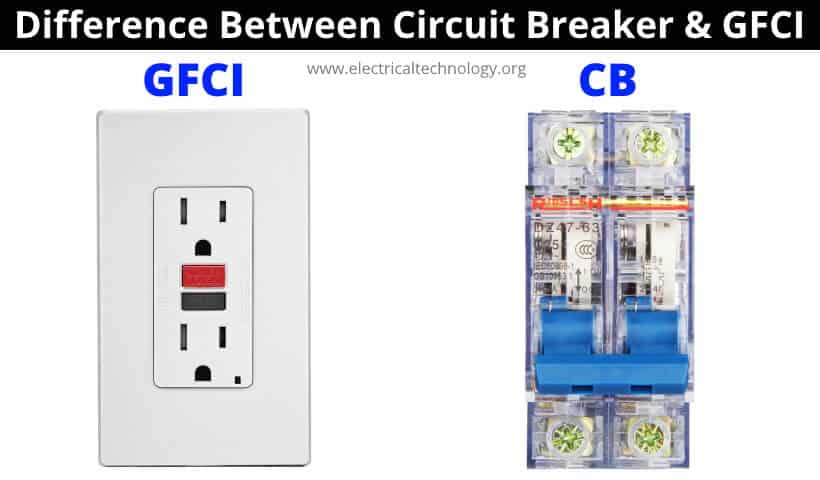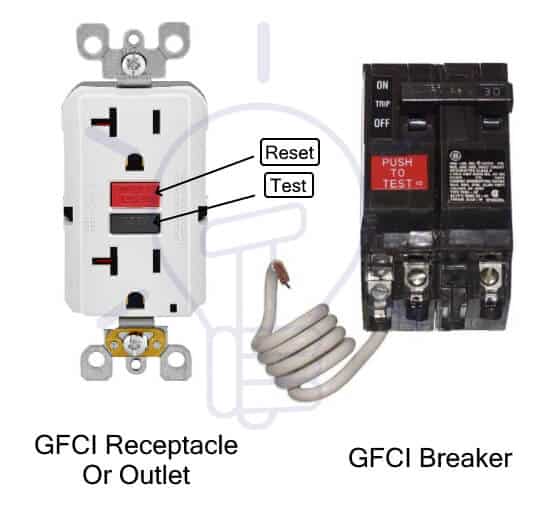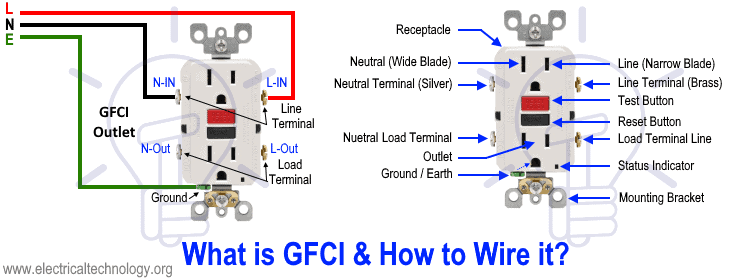Main Difference between a Circuit Breaker and a GFCI
The electricity just like a fire is a good servant but a bad master. You always need to keep it in control but if it ever gets out of control, it can cause serious injuries to you or damage your house. Therefore, we use multiple types of protection devices to prevent these electrical hazards. The circuit breaker & GFCI are two of the many types of electrical protection devices that we use in our household. Both of these devices offer protection against fault in electricity. Apart from that, the circuit breaker & GFCI are quite different.
- Related Post: Difference Between GFCI and AFCI
Before going into the differences between Circuit Breaker & GFCI, let’s discuss their basics first.
Circuit Breaker
Circuit Breaker is an automatically operated switch that protects a circuit from overloading or short circuits. It is used for protection against abnormal currents flowing in the circuit. It detects massive current surges or any short circuits & trips the supply to protect the wiring & house from further damage.
The current rating written on the circuit breaker plays an important role in its operation. It breaks the circuit or interrupts the current supply when the current exceeds this limit. The current may exceed due to numerous reasons such as; overloading, short circuit, huge spikes in the main lines. The overloading may occur due to several heavy loads connected with multiple outlets from a single circuit breaker or a faulty load connected in that outlet. The short circuit may occur due to exposed wires come into contact with each other because of deteriorated or damaged insulation.
For example, a circuit breaker rated 15 amps will automatically switch off & breaks the circuit when the current flowing in the circuit exceeds 15 amps.
The circuit breakers are installed in the main circuit breaker box or distribution board of a building. Each circuit breaker controls the current supply to a specific room or a specific area in that building. Any abnormal current conditions in that area will trip that specific circuit breaker, & causes to break the supply to every power point in that whole area. In order to resume the current supply, you have to manually reset the switch of the circuit breaker from the breaker panel.
- Related Post: Difference between Fuse and Circuit Breaker
GFCI (Ground Fault Circuit Interrupter)
GFCI or Ground Fault Circuit Interrupter is also a protective device that breaks the circuit when there is a current leak. It is used in wet locations or where electricity is used near water such as kitchen, bathroom, outdoor, garden & pools, etc. Using such outlets helps in prevention from getting electrical shocks that could end up fatal. You may also refer to the earthing and grounding tutorials.
It is an outlet with a built-in breaker that constantly compares the current flowing into the load “through Hot wire” & flowing out from the load “through neutral wire”. When there is a difference between the two, it pops off the breaker & breaks the power supply to the outlet. The difference occurs due to the leakage current flowing through the grounded body of a person when the appliance comes into contact with water.
The GFCI is a very sensitive device. It breaks the circuit when the leakage current exceeds around 5 milliamps which is very small current. It is relatively faster than a circuit breaker when it comes to breaking the circuit. It pops off the breaker in almost 1/40th of a second.
It has “Test Button” & “Reset Button” usually in black & red colors respectively. It is the main indication of any outlet that has GFCI protection. The “test button” is used for verification of its operation. It momentarily connects the live wire with the ground wire with in the outlet. The “Reset button” is used for resetting the power supply after it breaks. But you should not press it before disconnecting the appliances connected with it.
The GFCI will never trip due to overloading or any short circuit in the appliance connected. But it will trip the circuit breaker connected with the said GFCI outlet.
- Related Post: Difference Between Relay and Circuit Breaker
Key Differences Between Circuit Breaker and GFCI
| Circuit Breaker | GFCI |
| It is a protection device that protects any circuit against overloading & short circuit. | It is a protection device that protects any circuit against leakage current. |
| It breaks the circuit when the supplied current exceeds a certain limit. | It breaks the circuit when there is a current leakage in the circuit. |
| It senses the current flow in only the hot wire. | It senses the current in both hot wire & neutral wire. |
| It protects the circuit from overloading & catching fire due to heat. | It protects the person from getting an electrical shock. |
| It does not break the circuit due to electrical shock (current flowing through a person) except if the current exceeds the breaker’s rating. | It will not break the circuit due to overloading or short circuit in the appliance. |
| The rated current is usually very high. | The rated leakage current is very low below 6 milliamps. |
| There are no “Test & Reset” button on a simple circuit breaker. | There are “Test & Reset” buttons on a GFCI. |
| There is no “Test Button” to verify if the circuit breaker is working properly. | The “Test button” allow you to verify its leakage current detection. |
| It needs to be reset manually from the main breaker panel. | It needs to be reset by pushing the button on the same outlet. |
| It is installed in the main breaker box. | GFCI outlets are installed at power points while GFCI circuit breakers are installed in the main breaker box. |
| Every room or a specific area must have a circuit breaker. | According to NEC, GFCI must be installed in wet locations such as the bathroom, kitchen, outdoor etc. |
| It breaks the current supply to every power point or appliances in that area. | The GFCI being an outlet, breaks the supply only to the appliances connected to it. |
| The circuit breaker are cheaper than GFCI. | The GFCI are expensive than a circuit breaker. |
The conclusion of this topic is that the circuit breaker & GFCI both must be used in a building to offer protection against electrical accidents. But the GFCI must be used in wet locations to prevent electrical shock while the circuit breaker must be used in the electrical panels to prevent electrical fire due to overload & short circuit.
Related Posts:
- Difference Between MCB, MCCB, ELCB & RCB, RCD or RCCB Circuit Breakers
- Main Difference between Contactor and Starter
- Difference between Circuit Breaker and Isolator / Disconnector
- Difference Between Neutral, Ground and Earth
- Can We Use AC Circuit Breaker for DC Circuit & Vice Versa?
- How to wire a GFCI Circuit Breaker?
- How to Wire an AFCI Outlet?
- How to wire a GFCI Outlet?



 Why Does an Electric Tester Not Work in DC Circuits?
Why Does an Electric Tester Not Work in DC Circuits? Why Do The Positive And Negative Wires Spark When Touched?
Why Do The Positive And Negative Wires Spark When Touched? Difference Between Static Balancing and Dynamic Balancing
Difference Between Static Balancing and Dynamic Balancing What are the Cuts on the Rotor of Motor’s Armature?
What are the Cuts on the Rotor of Motor’s Armature? Why Do Wind Turbines Have 3 Blades Instead of 2 or 5?
Why Do Wind Turbines Have 3 Blades Instead of 2 or 5? Difference Between Edge Triggering and Level Triggering
Difference Between Edge Triggering and Level Triggering